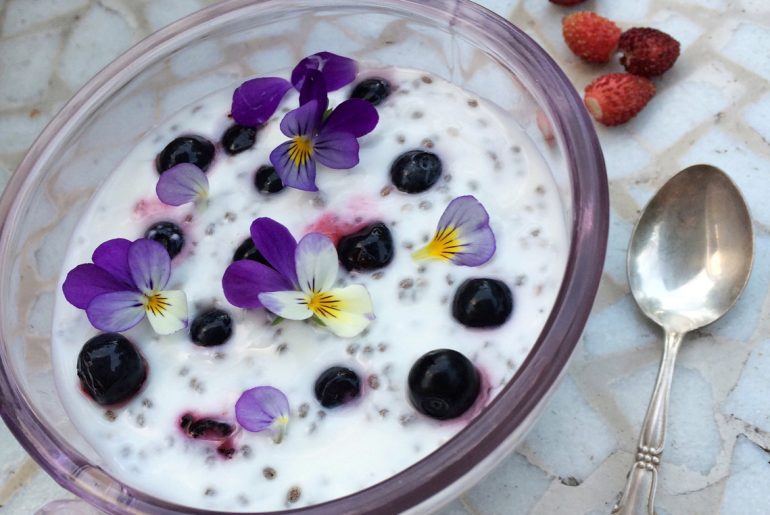Edible flowers are a fun way to add color to a cocktail or a meal — just be sure what you’re grabbing for in your garden won’t make you sick.
Denise Schreiber, edible flower expert and author of Eat Your Roses… Pansies, Lavender and 49 Other Delicious Flowers, has been a flower-as-food fan for decades. On a trip to England’s Mottisfont Abbey in 1999, Schreiber discovered rose petal ice cream and her interest blossomed from there.
“They had this little cup of of the ice cream, and once you put it in your mouth, it was the aroma of the rose on your tongue and in your mouth. It was fantastic,” said Schreiber. “When I came back to the States I started looking for recipes.”
The edible flower trend has recently been on the rise, largely thanks to social media — but harvesting flowers as food is nothing new. Flowers have been included in the human diet as far back as we have records for. Ancient Greeks, Romans and Chinese herbalists all recored various medicinal and culinary uses for flowers. It was their experimentation that ultimately paved the way for our safe consumption practices today.
Not every flower is edible, and some can even be poisonous, so stick with a few of the approved flowers listed below. Also, make sure you’re identifying the proper plant. Some flowers can look surprisingly similar to the untrained eye.
“You can eat a daylily but not an oriental lily. If you don’t know the difference, don’t eat them,” says Schreiber.
Some varieties can even add a nutritional boost to your meal. Nasturtiums are loaded with cancer-fighting lycopene and lutein, a carotenoid found in fruits and vegetables important for vision health. Peonies and roses can help you recover from post-workout inflammation and muscle recovery.
Most edible flowers will taste best raw, right after blooming. Just pick and rinse with water. We eat with our noses, so often how a flower smells will be how it tastes — with a bit more pepper to it.
“You should try to harvest in the early morning after the dew has dried but before the sun dries them out,” said Schreiber.
Flowers make great ad-ons to salads, baked goods or smoothies, but they are also perfect for flavoring oils, vinegars, honeys and syrups.
“Roses go very well with beef, chicken or pork — not so much fish,” said Schreiber.
“Lavender goes well with pork, chicken or fish. It’s also great fresh or dried in baked goods. I’m actually making lavender Russian tea cakes for an event soon. The trick to lavender is to use less than you think you need. You can always add more, but you don’t want to overdo it right away.”
You can find edible flowers locally farmers markets, or you may have some growing in your own backyard, but Schreiber urges never to get edibles from a garden center or a florist because those will always be treated with pesticides.
“You always want to make sure whatever you have hasn’t been treated with pesticides — very important. You want to make sure what you have is, in fact, an edible flower, and also that you didn’t find the flower so close to the side of the road that it could have been exposed to car exhaust or someone’s dog,” Schreiber cautions. “Also, I advise people with young children against giving their kids flowers because you don’t know yet what they’re allergic to.”
Visit www.edibleflowers1.com for Schreiber’s list of edible and inedible flowers.
“I encourage anyone to try it out,” said Schreiber. “It’s a lot of fun. It’s not meant to be serious. It’s just meant for a little fun with our food.”
Here are a few edible flowers from www.edibleflowers1.com.
Nasturtiums. Blossoms have a peppery taste. Best when used fresh. The leaves and seeds can be eaten too.
Marigolds. Try the Tangerine Gem and the Lemon Gem. The tiny flowers of these signet marigold blossoms taste like citrus.
Pansies and Johnny jump-ups. These flowers have a wintergreen flavor and look pretty on anything you put them on.
Calendula. Colors can range from yellow to orange or red. Remove the petals from the center of the flower and toss into salads. The petals can add gorgeous color to a mixed green salad.
Anise hyssop. If you like the taste of anise, you’ll like this flower. Add the florets to sweet or savory dishes or just use as a colorful garnish to a plate of cheese or a smoothie.
Chamomile. These small, daisy-like blooms give off a faint apple flavor.
Daylily buds. The buds and flowers are safe to eat and have a veggie-like flavor most resembling asparagus.
Squash blossoms. This term generally refers to zucchini blossoms, but most species of squash produce edible flowers. They’re frequently stuffed with filling or oven roasted.
Peonies. Add peonies to summer salads, punches and lemonades.
Roses. Rose petals are rich in fiber and help aid in digestion. Add some petals to water and crush with a mortal and pestle.
Wild Strawberry. Of course folks usually wait around for the delicious red fruit to come in, but the strawberry blossom is edible too. Toss it into salads and surprise your friends with this familiar, yet strange food.
Dandelions. While the whole plant is edible, the leaves, stems and even blooms can taste bitter if the plant has been there a while. For a mild, leafy taste, pick the leaves and bud right before they blossom, and make sure that any dandelions you harvest come from an organic yard and not one treated with pesticides.
For more edible flower ideas, visit www.edibleflowers1.com.
Denise Schreiber is schedule to speak this Sunday, June 25, 2017 at Destiny Hill Lavender Farm, 1069 South Main St., Washington, Pennsylvania. Time, TBA. For more information, contact Destiny Hill Lavender Farm at 724-222-3015.




